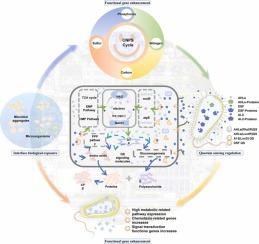Adaptive Resistance and Defense Evolution in Microplastics-Mediated Biological Exposure Interfaces in Municipal Wastewater Treatment Systems
IF 11.3
1区 环境科学与生态学
Q1 ENGINEERING, ENVIRONMENTAL
引用次数: 0
Abstract
To test the hypothesis that microplastic (MP)-mediated BXI triggers quorum sensing (QS)-driven resistance evolution, we established a multilevel mechanism: interface biological exposure → structural/functional changes → functional gene enhancement → QS activation → resistance/defense evolution. The results confirm that three MP (PET, PE, and PP)-mediated biological exposures induce the overexpression of genes encoding extracellular polymeric substances (EPS), stabilize microbial aggregates (proteins/enzymes), and promote BXI formation while reducing catalase/superoxide dismutase inhibition. MP exposure correlated with altered microbial communities, enriched stress resistance genera (Acinetobacter, Nitrospira, and Hyphomicrobium), and resulted in the formation of robust co-occurrence networks (73.53–90.67% positive correlations). Enhanced QS signaling (AI-2, DSF, and c-di-GMP) upregulated autoinducer/transporter genes, accelerating EPS synthesis and energy metabolism. MP-mediated BXI strengthens microbial resilience and nitrogen/sulfur cycle equilibrium via organic carbon degradation, nitrification–denitrification enhancement, and sulfite/thiosulfate oxidation, whereas protein–enzyme synergy improves pollutant resilience. Through signal compensation and pathway adaptation, microbial communities stabilize BXI under MP stress. These findings provide novel insights into the in situ control of MP-driven pollutant migration in MWTS.

城市污水处理系统中微塑料介导的生物暴露界面的适应性抵抗和防御进化
为了验证微塑性(MP)介导的BXI触发群体感应(QS)驱动的抗性进化假说,我们建立了一个多层次的机制:界面生物暴露→结构/功能改变→功能基因增强→QS激活→抗性/防御进化。结果证实,三种MP (PET, PE和PP)介导的生物暴露诱导编码细胞外聚合物质(EPS)的基因过表达,稳定微生物聚集体(蛋白质/酶),促进BXI的形成,同时减少过氧化氢酶/超氧化物歧化酶的抑制。MP暴露与改变的微生物群落、丰富的抗逆性属(不动杆菌、硝化螺旋菌和菌丝菌)相关,并导致形成强大的共生网络(73.53-90.67%正相关)。增强的QS信号(AI-2、DSF和c-di-GMP)上调了自诱导剂/转运体基因,加速了EPS合成和能量代谢。mp介导的BXI通过有机碳降解、硝化-反硝化增强和亚硫酸盐/硫代硫酸盐氧化增强微生物恢复力和氮/硫循环平衡,而蛋白质-酶协同作用增强污染物恢复力。MP胁迫下,微生物群落通过信号补偿和途径适应稳定BXI。这些发现为MWTS中mp驱动的污染物迁移的原位控制提供了新的见解。
本文章由计算机程序翻译,如有差异,请以英文原文为准。
求助全文
约1分钟内获得全文
求助全文
来源期刊

Journal of Hazardous Materials
工程技术-工程:环境
CiteScore
25.40
自引率
5.90%
发文量
3059
审稿时长
58 days
期刊介绍:
The Journal of Hazardous Materials serves as a global platform for promoting cutting-edge research in the field of Environmental Science and Engineering. Our publication features a wide range of articles, including full-length research papers, review articles, and perspectives, with the aim of enhancing our understanding of the dangers and risks associated with various materials concerning public health and the environment. It is important to note that the term "environmental contaminants" refers specifically to substances that pose hazardous effects through contamination, while excluding those that do not have such impacts on the environment or human health. Moreover, we emphasize the distinction between wastes and hazardous materials in order to provide further clarity on the scope of the journal. We have a keen interest in exploring specific compounds and microbial agents that have adverse effects on the environment.
 求助内容:
求助内容: 应助结果提醒方式:
应助结果提醒方式:


